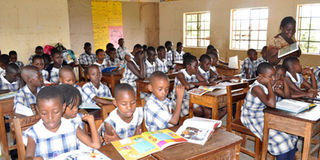Prime
69% of P3 pupils cannot read alphabet, says report

Literacy. Pupils with reading materials in class being guided by their teacher during the Booking Reading Day in 2018. PHOTO | FILE
What you need to know:
- According to a latest baseline assessment report on children’s learning outcomes, even if one spends more than 30 minutes on a letter, more than half of Primary Three learners who are in the study districts of Lira, Oyam, Kole, and Arua cannot recognise it.
At least 69 of 100 Primary Three pupils in northern Uganda cannot recognise alphabetical letters, a new report has said.
According to a latest baseline assessment report on children’s learning outcomes, even if one spends more than 30 minutes on a letter, more than half of Primary Three learners who are in the study districts of Lira, Oyam, Kole, and Arua cannot recognise it.
The situation is not different from local languages: Luo, Kiswahili, Kakwa, Lugbarati, and Aringa.
The percentage of children who cannot read or even do not recognise letters of the alphabet increased from 40.5 percent in 2018 to 55 percent in 2021.
This is according to an August 2021 baseline survey report that was launched on June 30. This assessment was commissioned by non-governmental organisations: Foundation for Inclusive Community Help (FICH) and Grassroots nest for Innovations and Change (GRIC.
The survey was titled: “Assessing quality, access, and capacity of grassroots organisations in improving learning outcomes in Oyam, Lira, Kole, and Arua districts”.
The study population consisted of 457 (227 girls and 230 boys) both in-school and out-of-school children aged 6 to 17 years; parents/guardians/caregivers of children aged below 18 years.
A total of 42 primary schools were randomly sampled using Stata15 software. In each of the schools, a test was administered to a sample of 20 pupils (about 10 in lower class and 10 in upper class). The assessment shows that 26 out of 100 pupils in Primary Six were able to answer one or two comprehension questions correctly.
In this class, 46 children out of 100 in the study districts were able to solve at least two subtraction problem solutions with borrowing, while 33 out of 100 learners in the same class were able to solve at least two addition problem solutions.
The best performance was registered in Primary Seven with 39 percent of the learners able to answer one or two comprehension questions correctly.
Mr Stephen Okoch, a researcher, said: “Generally, those in Primary Seven performed slightly higher than their counterparts who are not in that level (those in lower classes). However, the lowest performance was noted in Primary Two where you have only 1 percent able to mention that this is zero, this is one; this is two.”
Overall, girls performed better than boys in literacy; 41 percent of girls and 39 percent of boys were able to read words, construct a sentence, read a paragraph and be able to comprehend a story.
Methodology
In order to achieve the principal purpose of this evaluation, the survey employed a combination of quantitative and qualitative approaches and tools.
Dr Mary Goretti Nakabugo, the executive director of Uwezo Uganda, a not-for-profit organisation, blamed the challenges on Covid-19 pandemic.
Uwezo Uganda is working to promote equitable quality education in Uganda and beyond through research, learning assessments, innovations, partnerships, and advocacy.
Dr Nakabugo said when they did the assessment in 2018, about 13 out of 100 children in Primary Three did not recognise a letter of the alphabet.
“So, you would expect that the situation would worsen after the two years of school closure due to Covid-19. When it comes to the non-readers, in August 2021 when we did the assessment, that percentage had increased from 13 percent or 12.7 percent in 2018 to 25 per cent. The number had already almost doubled,” she said.
Mr Raymond Obiayi Ombere, the Arua City principal education officer, said: “As a government, the report is going to be a reference to improve the policy and strategies that foster better learning outcomes for children.”
Mr Ombere said the government is putting efforts to recover learning losses through the abridged curriculum and remedial classes.
objective
Mr Emmy Zoomlamai Okello, the executive director of FICH, said the objective of the survey was to assess the current literacy and numeracy proficiency levels of vulnerable children in primary one up to primary seven.




